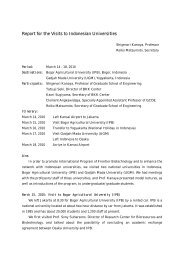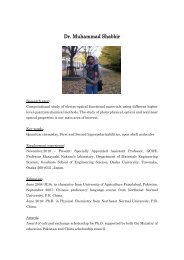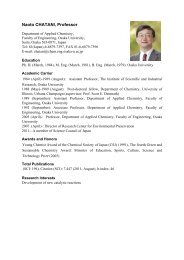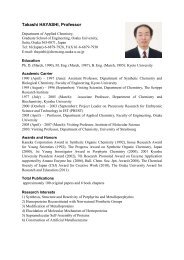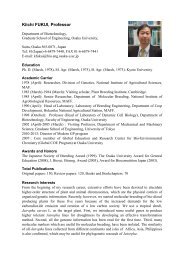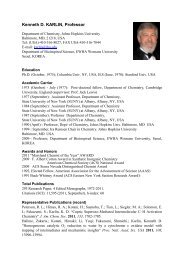Dr. Mohamed El-Khouly - Osaka University
Dr. Mohamed El-Khouly - Osaka University
Dr. Mohamed El-Khouly - Osaka University
You also want an ePaper? Increase the reach of your titles
YUMPU automatically turns print PDFs into web optimized ePapers that Google loves.
<strong>Mohamed</strong> <strong>El</strong>-<strong>Khouly</strong><br />
Research Area: Photoinduced <strong>El</strong>ectron Transfer of Molecular and Supramolecular Donor-Acceptor<br />
Systems: Toward Solar Energy Harvesting Systems<br />
EDUCATION<br />
1991 Bechlor of Science, Department of Chemistry, Tanta <strong>University</strong>, Egypt<br />
1996 Master of Science, Department of Chemistry, Tanta <strong>University</strong>, Egypt<br />
2002 Doctor of Philosophy, Department of Chemistry, Tohoku <strong>University</strong>, Japan<br />
Employment Experience<br />
1998–2002 Japan Government (MONBUSHO) Scholarship, PhD, Tohoku <strong>University</strong>, Japan.<br />
2003–2004 Post-Doctoral Fellow, Venture Business Laboratory Post-Doctoral Fellowship, Chiba<br />
<strong>University</strong>, Japan.<br />
2004-2005 Post-Doctoral Fellow, Center of Excellence (COE), Tohoku <strong>University</strong>, Japan<br />
2005–2007 Post-Doctoral Fellow, Japan Society for the Promotion Science (JSPS), Tohoku<br />
<strong>University</strong>, Japan.<br />
2008–2008 Visiting Researcher, Bremen, Germany.<br />
2008–2010 Post-Doctoral Fellow, JST, <strong>Osaka</strong> <strong>University</strong>, Japan.<br />
2010–2011 Post-Doctoral Fellow, COE, <strong>Osaka</strong> <strong>University</strong>, Japan.<br />
1
Research Interests<br />
Using the basic chemistry of photosynthesis to harvest solar energy for use by humanity<br />
has long been a dream of photochemists. There are many approaches to achieving this goal. In my<br />
study, I utilize organic chromophores and electron and energy donors and acceptors that may be<br />
related to those found in natural reaction centers. These moieties are linked by covalent bonds that<br />
replace one role of the protein matrix by controlling donor-acceptor electronic coupling. The<br />
artificial photosynthetic systems absorb sunlight and use the resulting energy to carry out basic<br />
processes such as energy transfer, photoinduced electron transfer, and photoisomerization. Their<br />
design criteria are based on the principles of natural photosynthesis. The behavior of these<br />
molecules is studied using ultrafast laser spectroscopy, cyclic voltammetry, molecular orbital<br />
calculations, scanning probe microscopy, and other methods. Although such artificial reaction<br />
centers do not reproduce all aspects of the much more sophisticated natural reaction centers, they<br />
can approach the performance of the natural ones in terms of the quantum yield of charge<br />
separation, the fraction of photon energy conserved, and the lifetime of photoinduced charge<br />
separation.<br />
Selected Publications<br />
1. <strong>Mohamed</strong> E. <strong>El</strong>-<strong>Khouly</strong>, Dong Kyu Ju, Kwang-Yol Kay, Francis D`Souza, and Shunichi<br />
Fukuzumi. Supramolecular Tetrad of Subphthalocyanine-Triphenylamine-Zinc Porphyrin<br />
Coordinated to Fullerene as “Antenna-Reaction Center” Mimic: Formation of Long-Lived Charge-<br />
Separated State in Non-Polar Solvent. Chemistry-A European Journal 2010, 15, 4528-4523.<br />
2. <strong>Mohamed</strong> E. <strong>El</strong>-<strong>Khouly</strong>, Ki-Jong Han, Kwang-Yol Kay, and Shunichi Fukuzumi.<br />
Stabilization of the Charge-Separated States of the Covalently Linked Zinc Porphyrin-<br />
Triphenylamine-[60]Fullerene: Spectroscopic, <strong>El</strong>ectrochemical, Computational and <strong>El</strong>ectron<br />
Transfer Studies. ChemPhysChem. 2010, 11, 1726-1734.<br />
3. <strong>Mohamed</strong> E. <strong>El</strong>-<strong>Khouly</strong>, Yu Chen, Xiaodong Zhuang and Shunichi Fukuzumi, Long-Lived<br />
Charge-Separated Configuration of a Push-Pull of Archetype of Disperse Red 1 End-Capped<br />
Poly[9,9-Bis(4-Bis(diphenylaminphenyl)fluorene). Journal of the American Chemical Society,<br />
Commun. 2009, 131 (18), 6370-6371.<br />
4. <strong>Mohamed</strong> E. <strong>El</strong>-<strong>Khouly</strong>, Jung Bok Ryu, Kwang-Yol Kay, Osamu Ito and Shunichi Fukuzumi,<br />
Long-Lived Charge Separation in a Dyad of Closely-Linked Subphthalocyanine-Zinc Porphyrin<br />
Bearing Multiple Triphenylamines. The Journal of Physical Chemistry C 2009, 113 (34), 15444–<br />
15453.<br />
5. <strong>Mohamed</strong> E. <strong>El</strong>-khouly, Jung Hoon Kim, Kwang-Yol Kay, Chan Soo Choi, Osamu Ito, and<br />
Shunichi Fukuzumi, Synthesis and Photoinduced Intramolecular Processes of Light-Harvesting<br />
2
Silicon Phthalocyanine-Naphtalenediimide-Fullerene Connected Systems. Chemistry - A European<br />
Journal 2009, 15 (18), 4528-4533.<br />
6. <strong>Mohamed</strong> E. <strong>El</strong>-<strong>Khouly</strong>, S. H. Shim, Y. Araki, O. Ito, K.-Y. Kay. Effect of dual fullerenes on<br />
lifetimes of charge-separated states of subphthalocyanine triphenylamine fullerene Molecular<br />
Systems. Journal of the Physical Chemistry 2008, 112, 3910-3917.<br />
7. <strong>Mohamed</strong> E. <strong>El</strong>-<strong>Khouly</strong>, E. S. Kang, K.-Y. Kay, C. S. Choi, Y. Aaraki and O. Ito. Novel<br />
silicon phthalocyanine-cored fullerene dendrimers: synthesis and prolonged charge-separated states<br />
with dendrimer generations. Chemistry - A European Journal 2007, 13, 2854-2863.<br />
8. <strong>Mohamed</strong> E. <strong>El</strong>-<strong>Khouly</strong>, P. Padmawar, Y. Araki, S. Verma, Long Y. Chiang and O. Ito.<br />
Photoinduced processes in a tricomponent molecule consisting of diphenylaminofluorenedicyanoethylene-methano[60]fullerene.<br />
The Journal of Physical Chemistry A 2006, 110(3), 884-891.<br />
9. <strong>Mohamed</strong> E. <strong>El</strong>-<strong>Khouly</strong>, O. Ito, P. M. Smith and F. D’Souza. Inter and supramolecular<br />
photoinduced electron transfer processes of porphyrin fullerene and phthalocyanine-fullerene donoracceptor<br />
systems. Journal of Photochemistry and Photobiology C: Review 2004, 5, 79 -104.<br />
10. F. D’souza, G. R. Deviprasad, <strong>Mohamed</strong> E. <strong>El</strong>-<strong>Khouly</strong>, M. Fujitsuka and O. Ito. Probing<br />
the donor-acceptor proximity on the phyisco-chemical properties of porphyrin-fullerene dyads “tailon”<br />
and “tail-of” binding approach. Journal of the American Chemical Society 2001, 123, 5277-5284.<br />
11. S. Fukuzumi, H. Imahori, H. Yamada, <strong>Mohamed</strong> E. <strong>El</strong>-<strong>Khouly</strong>, M. Fujitsuka, O. Ito and D.<br />
M. Guldi. Catalytic effect of dioxygen on intramolecualr electron transfer in radical pairs of zinc<br />
porphyrin-linked fullerenes. Journal of the American Chemical Society 2001, 123, 2571-2575.<br />
3



